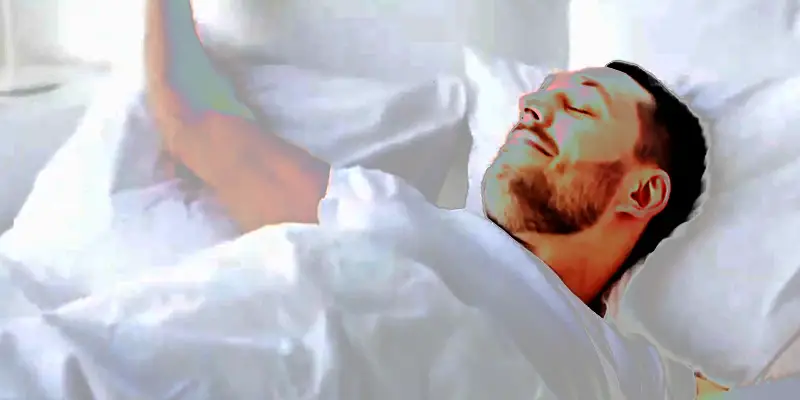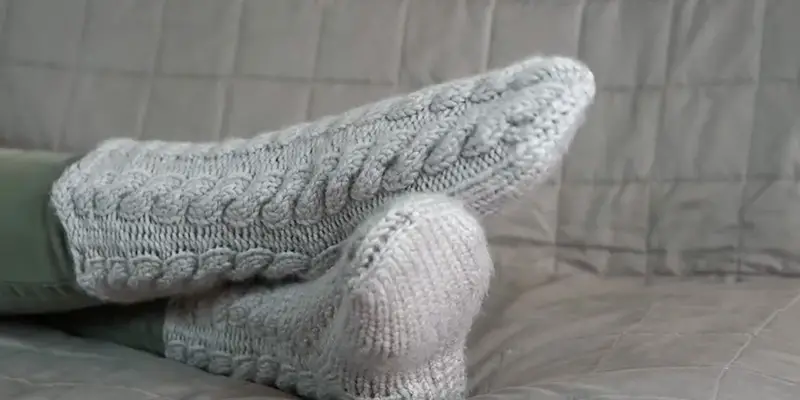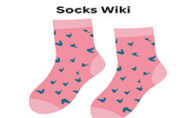Hi, I'm Christopher Bevans, the creator of SocksWiki.com. With a background in fashion design and a passion for innovation, I’m here to share my knowledge on socks from troubleshooting tips to detailed buying guides. I believe the right pair of socks can make all the difference, and through this site, I aim to help you find the perfect fit for every occasion.
Hi, I'm Christopher Bevans, the creator of SocksWiki.com. With a background in fashion design and a passion for innovation, I’m here to share my knowledge on socks from troubleshooting tips to detailed buying guides. I believe the right pair of socks can make all the difference, and through this site, I aim to help you find the perfect fit for every occasion.
No, wearing socks while sleeping does not cause any eye problems; rather, this is a common practice for many, believed to promote warmth and comfort during the night.
However, a lesser-known concern revolves around its potential impact on eye health. Some theories suggest that wearing socks to bed may lead to eye problems due to increased body temperature, which could affect the eyes’ natural cooling mechanism.
Additionally, proponents of traditional Chinese medicine propose a connection between foot warmth and eye health.
Yet, scientific evidence supporting these claims remains limited. This blog explores the question: Does wearing socks while sleeping cause eye problems?
Delving into existing research and expert opinions, we seek to shed light on this intriguing topic.

Does Wearing Socks While Sleeping Cause Eye Problems?
The idea that wearing socks during sleep could cause eye problems, however, lacks scientific evidence and is more rooted in myth than fact.
Wearing socks while sleeping is a common practice for many people, particularly those who seek extra warmth or improved sleep quality.
Let’s break down the connection between wearing socks during sleeping and eye health:
Myths and Misconceptions
The belief that wearing socks while sleeping can cause eye problems is largely a myth with no scientific backing.
Myths like these often arise from misunderstandings about how the body functions. For example, some people might think that wearing socks constricts blood flow to the point where it could affect other parts of the body, including the eyes.
However, there is no anatomical or physiological pathway that supports this idea. The circulatory system is highly adaptive and can manage minor changes such as wearing socks without causing harm to the eyes.
Circulation and Temperature Regulation
When you wear socks, they help keep your feet warm, promoting vasodilation, or the widening of blood vessels.
This can improve blood flow and aid in temperature regulation, which is crucial for good sleep.
While proper circulation is essential for overall health, it does not have a direct impact on the eyes in a way that would cause damage.
Instead, maintaining good circulation supports general well-being without any negative repercussions for eye health.
Direct Impact on Eyes
The eyes are primarily affected by factors such as genetic predisposition, environmental exposures, and lifestyle habits. Wearing socks while sleeping does not interact with these factors.
The health of the eyes depends more on things like maintaining proper hydration, avoiding excessive screen time, and protecting them from harmful UV rays. None of these factors are influenced by whether or not you wear socks to bed.

Advantages of Wearing Socks While Sleeping
Wearing socks to bed is a simple practice that can offer several notable benefits.
These benefits primarily revolve around enhancing sleep quality, promoting overall comfort, and addressing specific health concerns.
Here are some key advantages of wearing socks while sleeping:
Improved Sleep Quality
- Temperature Regulation: Wearing socks can help regulate your body temperature by keeping your feet warm.
This can lead to vasodilation, where blood vessels widen and help the body cool down slightly, signaling to your brain that it’s time to sleep.
This can help you fall asleep faster and enjoy a more restful night.
- Comfort and Relaxation: Warm feet can provide a sense of comfort and relaxation, making it easier to unwind and fall asleep.
This is particularly beneficial in colder environments or during winter months.
Prevention of Nighttime Cold Feet
- Avoiding Cold Disruptions: Cold feet can be uncomfortable and may wake you up during the night.
Wearing socks can help maintain a consistent level of warmth, preventing disruptions and contributing to uninterrupted sleep.
Enhanced Circulation
- Support for Circulatory Health: Wearing socks can aid in maintaining good blood circulation, particularly important for individuals with certain health conditions like diabetes.
Warm feet can improve blood flow and reduce discomfort caused by poor circulation.
- Raynaud’s Disease Management: For individuals with Raynaud’s phenomenon, a condition where blood flow to the extremities is reduced, wearing socks to bed can help prevent painful episodes triggered by cold temperatures.
Moisturization Benefits
Skin Health: Wearing socks can help retain moisture in your feet, preventing dryness and cracking.
This is especially beneficial if you apply a moisturizing lotion before putting on your socks, as it helps lock in the moisture and keeps your feet soft and hydrated.
Reduced Risk of Hot Flashes
Menopausal Relief: For women experiencing menopause, hot flashes can be a significant sleep disruptor.
Wearing socks can help stabilize your core body temperature, potentially reducing the frequency and intensity of hot flashes during the night.
Support for Insomnia Management
Calming Effect: The warmth provided by socks can have a calming effect, helping those with insomnia find it easier to relax and fall asleep.
The sensation of warmth and comfort can be particularly soothing and conducive to sleep.

Side Effects of Wearing Socks to Bed or During Sleeping
While wearing socks to bed has its benefits, there are also potential disadvantages to consider.
These downsides can range from minor discomfort to more serious health concerns depending on individual circumstances and the type of socks worn.
Overheating
Disrupted Sleep: Wearing socks that are too thick or made from non-breathable materials can lead to overheating. Overheating can cause discomfort, night sweats, and disrupt sleep.
Maintaining a comfortable body temperature is essential for restful sleep, and socks that trap too much heat can interfere with this balance.
Reduced Circulation
- Tight Socks: Socks that are too tight can constrict blood flow, leading to discomfort and potential circulatory issues.
- This is particularly concerning for individuals with circulatory problems or diabetes, as restricted blood flow can exacerbate these conditions.
- Swelling: Tight socks can cause or worsen swelling in the feet and ankles, leading to discomfort and potentially more serious health issues if left unaddressed.
Hygiene Issues
- Bacterial and Fungal Growth: Wearing the same pair of socks for an extended period, especially overnight, can create a warm, moist environment that is conducive to bacterial and fungal growth.
This can lead to unpleasant odors and increase the risk of infections such as athlete’s foot.
- Skin Irritation: Continuous wear of socks, particularly if they are not clean or are made from synthetic materials, can cause skin irritation, rashes, or allergic reactions.
Comfort and Fit
- Discomfort from Seams and Elastic: Socks with prominent seams or tight elastic bands can cause discomfort and leave marks on the skin.
This discomfort can be particularly disruptive to sleep, causing people to wake up or experience restless sleep.
- Material Sensitivity: Some individuals may have sensitivities or allergies to certain sock materials.
Wearing such socks overnight can cause itching, redness, or other allergic reactions.
Potential for Dependency
Psychological Dependency: Some people may develop a psychological dependency on wearing socks to sleep, feeling unable to fall asleep without them.
While not inherently negative, it can become an inconvenience if they find themselves without socks in a situation where they need to sleep.
Impact on Natural Thermoregulation:
- Body’s Natural Cooling Process: The body naturally cools down during sleep as part of its circadian rhythm.
Wearing socks might interfere with this process, potentially disrupting the natural sleep cycle and reducing sleep quality.
Pros and Cons of Sleeping With Socks On
Sleeping with socks on can offer both benefits and drawbacks, affecting comfort, sleep quality, and health.
Here’s a concise overview of the pros and cons:
| Pros | Cons |
| Keeps feet warm | Can cause overheating |
| Improves circulation | Risk of fungal infections |
| Reduces chances of cracked heels | May disrupt sleep quality |
| Comfort for cold feet | Potential for foot odor |
| Prevents dry skin | May trigger restless leg syndrome (RLS) |
| Can promote relaxation | Increased risk of athlete’s foot |
| Provides comfort for some | Discomfort if socks are too tight |
| Reduces the risk of Raynaud’s | Difficulty regulating body temperature |
| Helps with insomnia for some | Socks may come off during sleep |
| Convenient for quick warmth | Sensory discomfort for some |

Wearing Socks While Sleeping in Winter
Wearing socks while sleeping in winter is a common practice for many individuals seeking warmth and comfort during chilly nights.
As temperatures drop, keeping the extremities warm becomes crucial for overall comfort and even health.
Here’s a closer look at the benefits and considerations of wearing socks to bed during the winter months:
Benefits:
- Maintains Warmth: Feet are often the first to feel cold during winter nights. Wearing socks insulates the feet, trapping heat and preventing heat loss, thus keeping the body warm.
- Improved Sleep Quality: Keeping feet warm, wearing socks to bed can promote better sleep quality.
Cold feet can be a significant disruptor of sleep, and warm socks help prevent discomfort and restlessness.
- Enhanced Circulation: Cold temperatures can constrict blood vessels, leading to reduced circulation.
Wearing socks can help promote blood flow to the feet, improving circulation throughout the body.
- Prevents Dry Skin: Winter air tends to be dry, which can cause skin to become dry and cracked. Socks provide a barrier, helping to retain moisture and prevent dryness.
- Reduces Risk of Health Issues: Cold feet increase the risk of conditions like Raynaud’s phenomenon, where blood vessels in the extremities constrict excessively in response to cold temperatures. Wearing socks can mitigate this risk.
Considerations:
- Overheating: While warmth is desirable, it’s essential not to overheat. Wearing excessively thick socks or layering too many blankets can lead to overheating and discomfort during sleep.
- Risk of Fungal Infections: Closed shoes and socks create a warm, moist environment conducive to fungal growth. It’s crucial to ensure socks are clean and dry to minimize the risk of fungal infections like athlete’s foot.
- Proper Fit: Socks that are too tight can restrict blood flow and cause discomfort. Opt for socks that provide a comfortable, snug fit without being too tight.
- Foot Odor: Wearing socks for extended periods, including while sleeping, can contribute to foot odor. Regularly washing socks and practicing good foot hygiene can help mitigate this issue.
- Personal Preference: Some individuals may find wearing socks to bed uncomfortable or restrictive.
It’s essential to consider personal preference and comfort when deciding whether to wear socks while sleeping.
Wearing Socks While Sleeping for Babies
Wearing socks while sleeping for babies is a common practice that caregivers often adopt to ensure the comfort and warmth of their little ones, especially during colder months.
Here’s a closer look at the considerations and benefits of this practice:
Benefits:
- Maintains Body Temperature: Babies are more susceptible to temperature changes than adults. Keeping their feet covered with socks helps regulate their body temperature, ensuring they stay warm and comfortable throughout the night.
- Promotes Better Sleep: Just like adults, babies can be sensitive to cold feet, which may disrupt their sleep.
Wearing socks provides insulation and helps prevent discomfort, allowing babies to sleep more soundly.
- Prevents Heat Loss: Babies lose heat more rapidly than adults due to their higher surface area to body mass ratio.
Socks act as an extra layer of insulation, reducing heat loss through their tiny feet and helping them retain warmth.
- Protects Feet: Socks provide a barrier between a baby’s delicate skin and any rough or abrasive surfaces in the crib, such as seams or tags. This can help prevent irritation and friction-related injuries.
- Encourages Circulation: While socks keep feet warm, they also promote healthy circulation by preventing excessive cooling of the feet, which can lead to vasoconstriction and poor blood flow.
Considerations:
- Breathability: It’s essential to choose breathable, moisture-wicking socks made from natural fibers like cotton or bamboo.
This helps prevent overheating and reduces the risk of excessive sweating, which can lead to skin irritation or fungal infections.
- Proper Fit: Socks should fit snugly but not too tightly. Avoid socks with tight elastic bands that may restrict circulation or leave marks on the baby’s skin.
- Safety Concerns: Ensure that socks are securely fastened and cannot become loose during sleep.
Loose socks could pose a choking hazard if they were to come off and be ingested by the baby.
- Temperature Regulation: Pay attention to room temperature and dress the baby appropriately.
In warmer environments, wearing socks may not be necessary and could potentially cause overheating.
- Monitoring for Signs of Discomfort: Check the baby’s feet periodically to ensure they are not too hot or too cold. Adjust the bedding or clothing layers accordingly based on the baby’s comfort level.
Is Wearing Socks All the Time Bad for Circulation?
Wearing socks all the time can potentially affect circulation, but whether it’s “bad” depends on various factors such as the type of socks, fit, material, and individual health conditions.
Here’s a breakdown:
Potential Effects on Circulation:
- Compression: Tight socks, especially those with restrictive elastic bands, can impede blood flow by compressing blood vessels.
This compression can lead to decreased circulation, particularly in the feet and lower legs.
- Risk of Blood Clots: Prolonged wearing of tight socks, especially if they are too constrictive, may increase the risk of developing blood clots, particularly in individuals predisposed to clotting disorders or those who have been immobile for extended periods.
- Nerve Compression: Tight socks can also compress nerves, leading to tingling sensations, numbness, or even nerve damage in severe cases.
This compression can occur anywhere along the foot and lower leg, affecting sensation and mobility.
- Temperature Regulation: Socks that are too thick or made from non-breathable materials can contribute to overheating, which may exacerbate circulatory issues.
Overheating can cause blood vessels to dilate excessively, leading to discomfort and potentially affecting circulation.
Factors to Consider:
- Sock Fit: Socks should fit comfortably without being too tight or too loose. Opt for socks with gentle, non-binding cuffs that do not leave marks on the skin.
Properly fitting socks allow for adequate circulation while still providing warmth and protection.
- Material: Choose socks made from breathable, moisture-wicking materials like cotton or bamboo.
These materials help prevent excessive sweating and maintain a healthy environment for the feet, reducing the risk of skin irritation and fungal infections.
- Activity Level: For individuals who are sedentary or have limited mobility, regularly changing socks and gently massaging the feet can help stimulate circulation and prevent stagnation.
Conversely, athletes or individuals with active lifestyles may benefit from compression socks to improve blood flow during physical activity.
- Underlying Health Conditions: Individuals with diabetes, peripheral artery disease (PAD), or other circulatory disorders should consult with a healthcare professional before wearing socks all the time, especially if they have concerns about circulation.
Certain conditions may require specific types of socks or adjustments to sock-wearing habits to mitigate potential risks.
FAQs
Does sleeping with socks affect vision?
There’s no scientific evidence directly linking sleeping with socks to vision problems. While some alternative medicine practices suggest a connection between foot warmth and eye health, conclusive research is lacking.
Why shouldn’t you sleep with socks on?
Sleeping with socks on can potentially disrupt temperature regulation and lead to overheating, discomfort, or skin irritation.
Additionally, tight socks may impede circulation, causing numbness or tingling. It’s essential to prioritize comfort and circulation while deciding whether to wear socks to bed.
Wrap Up
The notion of wearing socks while sleeping causing eye problems remains largely anecdotal, lacking substantial scientific support.
While traditional beliefs in some cultures suggest a connection between foot warmth and eye health, empirical evidence is limited.
Scientific inquiry into this topic is ongoing, yet definitive conclusions have not been reached.
It’s essential to approach such claims critically, considering individual comfort preferences and potential effects on overall sleep quality.
Ultimately, while socks may offer warmth and comfort during sleep, individuals should prioritize their eye health through regular check-ups and practices endorsed by medical professionals.

Hi, I'm Christopher Bevans, the creator of SocksWiki.com. With a background in fashion design and a passion for innovation, I’m here to share my knowledge on socks from troubleshooting tips to detailed buying guides. I believe the right pair of socks can make all the difference, and through this site, I aim to help you find the perfect fit for every occasion.
- Latest Posts by Christopher Bevans
-
Socks Smell Like Ammonia: Causes and Solution
- -
Best Socks Material for Sweaty Feet 2026
- -
What Socks to Wear With Cowboy Boots?
- All Posts


